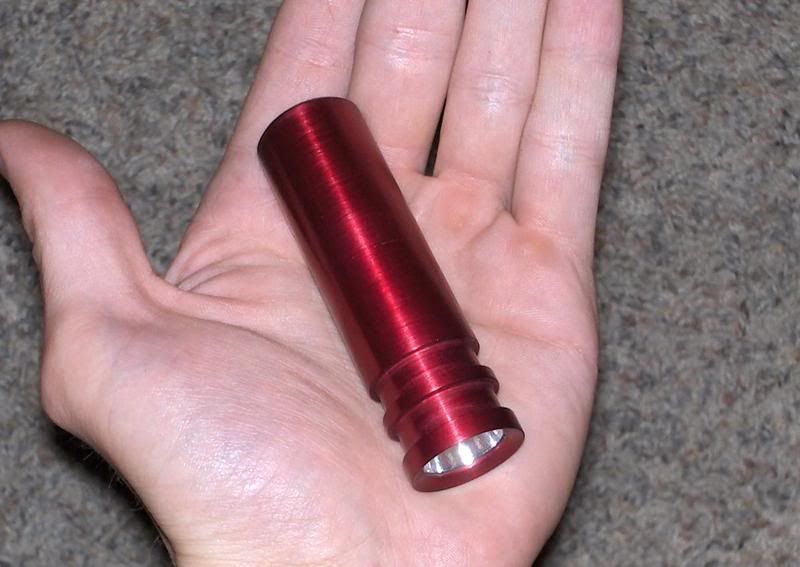Building another LED driver for a flashlight that I made. Right now It's using one of these drivers:
http://www.kaidomain.com/ProductDetails.aspx?ProductId=1801
3 AMC7135 chips, which are 350mA linear constant current regulators, and a control chip of some kind, I'm not exactly sure how it works, but the output isn't constant, I'd like to build a proper buck-boost driver for single cell Li-Ion input (2.7-4.2V).
I Have a couple of these chips: http://www.linear.com/pc/downloadDocument.do?navId=H0,C1,C1003,C1042,C1116,P15693,D10838
There are 2 enable pins that ground through 2 different current setting resistors. So you can have 3 light levels by energizing EN1, EN2, or both, and when both are grounded, no current is drawn.
Now I'm wondering how best I can utilize a momentary push button switch to cycle 2 outputs.
low, low
high, low
low, high
high, high
I was thinking of maybe using a SOIC 08M for the job, but how low of a voltage will one of these chips work to? Also how low can I possibly get the current draw? I'd like to keep the driver as efficient as possible.
Maybe there's some other more simple chip that could do the same job much more easily, but I don't really know what to even start looking for. I have some other LED drivers that I'd like to utilize adjustable output with.. grounding the LEDs through different Rsns resistors using FETs or something similar.. but these drivers are higher voltages, one of them up to 25V, so I suppose it wouldn't be too out of the question to use a small linear regulator to power a picaxe, but other drivers I have that are 50V would require a switching voltage supply for the picaxe I imagine.. since I need to keep things as small as possible, and simplicity is always good. Suggest away please!
And I always like to put some pics in my threads, so here's a couple of the flashlights I turned on my lathe, I also set up an anodizing tank.. these use high power CREE LEDs, one of them a warm white LED around ~2800K, very warm, the other is a ~5000K LED. Warmer LEDs have lower flux, but that one is extremely warm, I have some nice 3500K LEDs with a nice compromise between colour and flux.



http://www.kaidomain.com/ProductDetails.aspx?ProductId=1801
3 AMC7135 chips, which are 350mA linear constant current regulators, and a control chip of some kind, I'm not exactly sure how it works, but the output isn't constant, I'd like to build a proper buck-boost driver for single cell Li-Ion input (2.7-4.2V).
I Have a couple of these chips: http://www.linear.com/pc/downloadDocument.do?navId=H0,C1,C1003,C1042,C1116,P15693,D10838
There are 2 enable pins that ground through 2 different current setting resistors. So you can have 3 light levels by energizing EN1, EN2, or both, and when both are grounded, no current is drawn.
Now I'm wondering how best I can utilize a momentary push button switch to cycle 2 outputs.
low, low
high, low
low, high
high, high
I was thinking of maybe using a SOIC 08M for the job, but how low of a voltage will one of these chips work to? Also how low can I possibly get the current draw? I'd like to keep the driver as efficient as possible.
Maybe there's some other more simple chip that could do the same job much more easily, but I don't really know what to even start looking for. I have some other LED drivers that I'd like to utilize adjustable output with.. grounding the LEDs through different Rsns resistors using FETs or something similar.. but these drivers are higher voltages, one of them up to 25V, so I suppose it wouldn't be too out of the question to use a small linear regulator to power a picaxe, but other drivers I have that are 50V would require a switching voltage supply for the picaxe I imagine.. since I need to keep things as small as possible, and simplicity is always good. Suggest away please!
And I always like to put some pics in my threads, so here's a couple of the flashlights I turned on my lathe, I also set up an anodizing tank.. these use high power CREE LEDs, one of them a warm white LED around ~2800K, very warm, the other is a ~5000K LED. Warmer LEDs have lower flux, but that one is extremely warm, I have some nice 3500K LEDs with a nice compromise between colour and flux.








